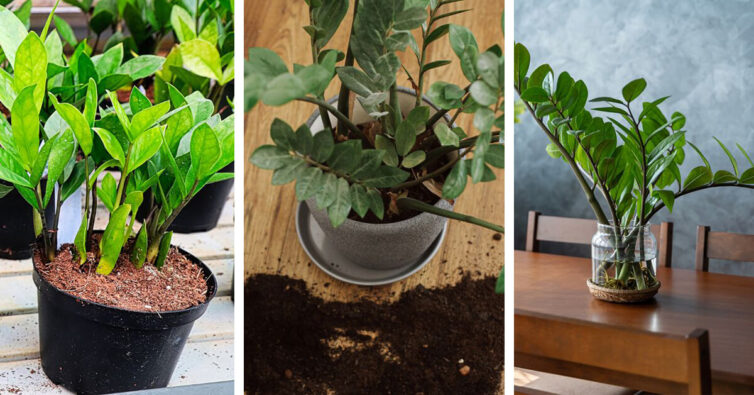The Zanzibar Gem Plant (Zamioculcas zamiifolia) received the easily remembered title of ZZ plant. Otherwise, it would be quite the tongue twister. ZZ plants originated in East Africa, Tanzania, and (wait for it) Zanzibar. This plant’s leaves are so dark green and waxy people mistake them as artificial until they get closer.
The ZZ has other nicknames such as the eternity plant, fat boy, and aroid palm. It is part of the Arum family tree, which includes houseplants like the peace lily, philodendrons, and Chinese evergreen.
ZZ Gem: Hardy & Resilient
If you are a new gardener (or you know someone who is), “easy” is its middle name. It is nearly impossible to kill. Even people with black thumbs can find success with this plant. There is very little to fuss over. Make sure it gets light, water it every two weeks, and watch it grow! And hey, if you get busy and forget a watering, don’t sweat it. These plants are drought tolerant.
The ZZ plant has a pace all its own. It’s a slow grower, so be patient. You should see a few new stems and a couple of inches of change in height.
When cared for properly, they can live up to 10 years. The oldest recorded ZZ plant was 20.
ZZ is one of several similar ornamentals called “money plant.” People associate ZZ with steady growth, diligence, symmetry, and enrichment. As a result, it’s not uncommon to use a ZZ plant as an office gift for a new job or promotion.
ZZ Plant Care 101
Check through your home for drafty areas and air conditioning ducts. Keep your ZZ well away from them. This plant flourishes best when the temperatures hover between 65 and 75 °F.
When you’re dusting your home, every so often, include your Zanzibar Gem. The leaves accumulate dust and dirt, decreasing their luster. No products are necessary. Just use a damp, soft cloth. This is an excellent opportunity to multitask. Check your plant for any signs of insects or disease.
Your Zanzibar Gem will grow toward the light. So rotate it every so often, exposing all sides to sunlight. Make sure it’s from an indirect source to avoid leaf burn.
While not actually a “care” tip, it’s best to buy a ZZ plant in the size you want. If you want a large one, don’t start small. You’ll wait a long time for it to grow.
All parts of the ZZ plant are poisonous. Chewing it causes a burning sensation and swollen lips. Swallowing some takes those reactions into the mouth, tongue, and throat. If you have sensitive skin, wear gloves when working with the Zanzibar Gem.
Zanzibar Gem Plant: Basic Needs
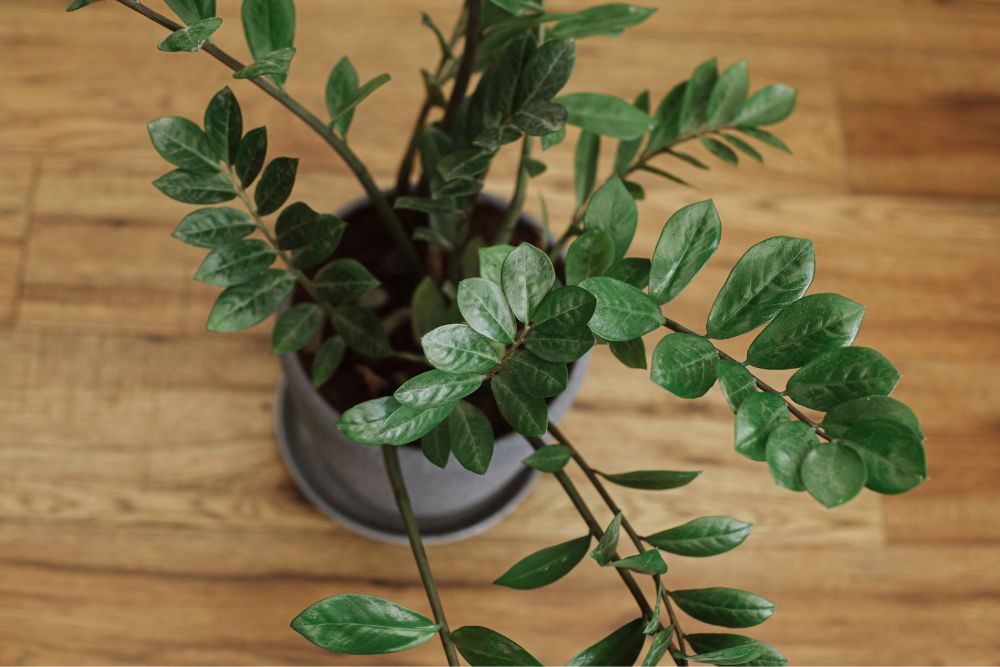
No one who buys a plant wants to watch it die. Thankfully, the ZZ plant doesn’t mind a little less attention than many other plants. So what do they need?
- Enrichment (Fertilizer): Use this to help increase the size of your plant. Add normal indoor plant fertilizer at half strength to the soil. For best results, wait until the growing season.
- Humidity: Good news! The Zanzibar Gem likes the humidity in normal houses (40%).
- Light: The ZZ plant can abide by low light conditions for a while. Eventually, they will become leggy from this position. A better choice is setting the planter in an area with indirect light. South-facing windows provide plenty of sun, but don’t expose your plant to the noonday sun.
- Soil: You can use any well-draining potting soil mixed with perlite or sand. Having said that, a better choice is cactus or succulent soil.
- Temperature: The Zanzibar Gem misses its original home. Exposing it to cold doesn’t fare well. Temperatures lower than 45 °F can harm the plant severely.
- Water: This plant won’t need overly frequent watering. In fact, being a little on the dry side suits it just fine. When you touch the soil, and it’s dry (about every 2 weeks), it’s time to water. It is far better to underwater your ZZ plant a bit than overwater it.
Propagating Zanzibar Gems
The simplest way of propagating this plant is through division. When you change pots, remove the rhizomes and move them to another container. Alternatively, you can begin with cuttings.
Step one is gathering an entire stalk. Gently snip off the bottom leaves. Place the leafless end into a clear jar of water. Refresh the water regularly (once a week) to deter the chance of bacterial growth. In six to nine months, you’ll have roots forming. Wait until you have a bundle, then plant it in the soil, caring for it as any ZZ plant thereafter.
Shopping for ZZ Plants
Sometimes one green thingy looks like another green thingy. ZZ plants may look a bit alike, but there are several varieties from which to choose.
- Lucky Variegated: This is a pretty ZZ with white, yellow, and green leaves. You’ll find some that are almost completely green if you’re fortunate. The lucky variegate will need a little more time exposed to indirect sunlight than some other choices.
- Raven: There is no misidentifying this plant. It has deep purple leaves, some looking almost raven black. It’s a relative newcomer that gives new meaning to “black tie” in terms of style. The dark color accommodates a variety of decors.
- Super Nova: Akin to Raven, the Super Nova has ink-black foliage. The difference is that Super Nova has more green appearing like painter’s flecks on the leaves.
- Zamicro: A shorter-stemmed dwarf ZZ. Hunter green leaves remain slightly curled. It looks different in all the right ways.
- Zenzi (HANSOT113): This plant has compact growth with little leaflets on each leaf. Their foliage is straight and stiff. As it grows, its shape becomes wide at the bottom and thinner at the top.
The University of Copenhagen revealed ZZ plants as air purifiers, at least in the lab. It can remove compounds like xylene, benzene, and ethylbenzene. It is difficult to measure indoor effectiveness because each home is different.
Watering your ZZ Plant
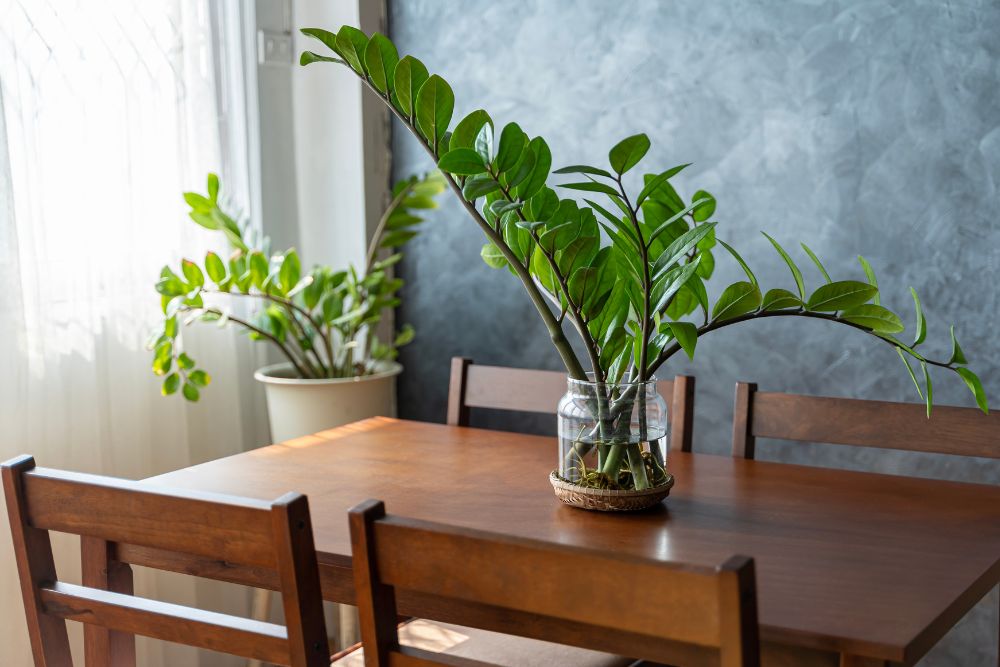
When your Zanzibar Gem turns yellow and drops leaves, it’s a sign of dehydration. Give it a drink! Take the plant to your sink and shower it. Water should flow out the bottom holes of the pot. Stop, and let it finish dripping before you put it back in place.
You shouldn’t need to water your plant more than every week to two weeks. In this matter, get to know your plant. Eventually, you’ll be able to read the signs of when to water. Most plants have a biorhythm. You just have to learn it.
If the plant is in low light conditions, its watering needs lessen. Conversely, those in brighter light may need more. The Zanzibar Gem can go for about three weeks without water thanks to the reservoir their rhizomes provide.
Your ZZ plant also appreciates misting. They like humidity.
Petal Power: The Zanzibar Gem doesn’t typically flower until at least two years old. They look a bit like jack-in-the-pulpit or peace lilies, both of which are in the same family as the ZZZ, Araceae.
Potting and Repotting Indoor Zanzibar Gem Plants
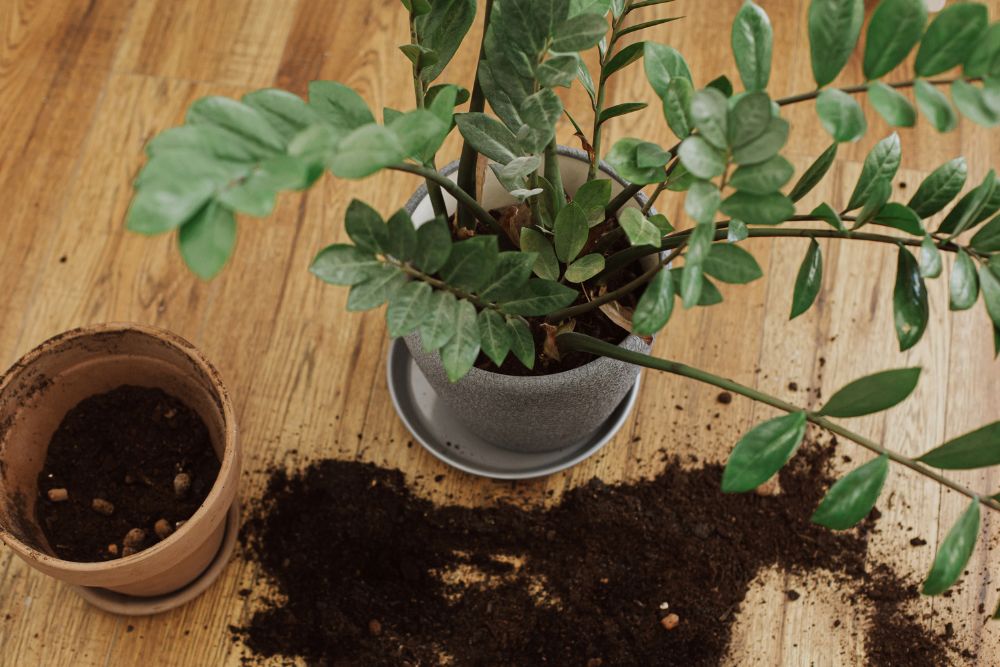
When you first get your ZZ plant home, you want to transfer it to a fresh container with good potting soil. Succulent soil is a good option. Toss out the old stuff. It may have no more nutritional value or, worse, contain diseases.
ZZ plants aren’t fast growers. Nonetheless, you may have to repot yours from time to time. If you see the rhizomes peeking out of the container, it’s time. Spring or summer is the best time to repot.
Look for a crock that’s 2” larger in diameter than the present one. Move the whole plant to a place where you can spread out some newspaper. Remove the plant, shaking off old soil. Discard the old soil. Put your ZZ center stage of the pot and begin adding new soil, patting it down as you go. Now you’re ready to water, and put your ornamental back where it belongs.
When you think of tough, Zanzibar Gem roots are very strong. Sometimes they literally crack a pot! Talk about communication! Its oil if the roots remain compacted for a bit. The averaging repotting time is every two years.
Indoor Zanzibar Gem Plant Pruning and Maintenance
You really don’t have to worry much about pruning. ZZs pretty much shape themselves. Remove dead leaves year-round along with damaged stalks. Brown leaves will never recover, and they just eat up some of the plant’s energy.
If you’re pruning for the purpose of size control, wait until growing season. Always use clean, sharp utensils (no sawing, please). Keep cuts clean and trim only the plant’s tips. Never remove more than about 20% of your overall plant. You can send it into shock.
Zanzibar Gem’s Significance in Feng Shui
ZZs are auspicious plants that support harmony and attract good fortune. When inside the home, the whole family experiences prosperity along with more opportunities. Can anyone say “housewarming gift?”
Much of the symbolic value for ZZs comes from its characteristics. For example, there’s consistency and slow and steady growth. Do a job right the first time. Next, there’s perseverance. There is little you cannot overcome if you remain diligent and work hard.
Within your home, place the Zanzibar Gem in the northeast area of the home for success and wealth. If you have a business, keep one near the cash registers to draw in customers.
Blooming and Resting Periods in ZZ Plants
If your indoor ZZ plant is following mother nature’s cycle, it will go dormant during winter. Their growth slows to a near halt. Rather than push energy into the top, ZZs keep it under the soil for developing root systems and rhizomes. Ease up on fertilizing and watering.
Eternity and Beyond: ZZ bears the title “Eternity Plant” because of some superstitions claiming it can live forever. The scientific name for the plant comes from cycads, which were ancient plants predating dinosaurs.
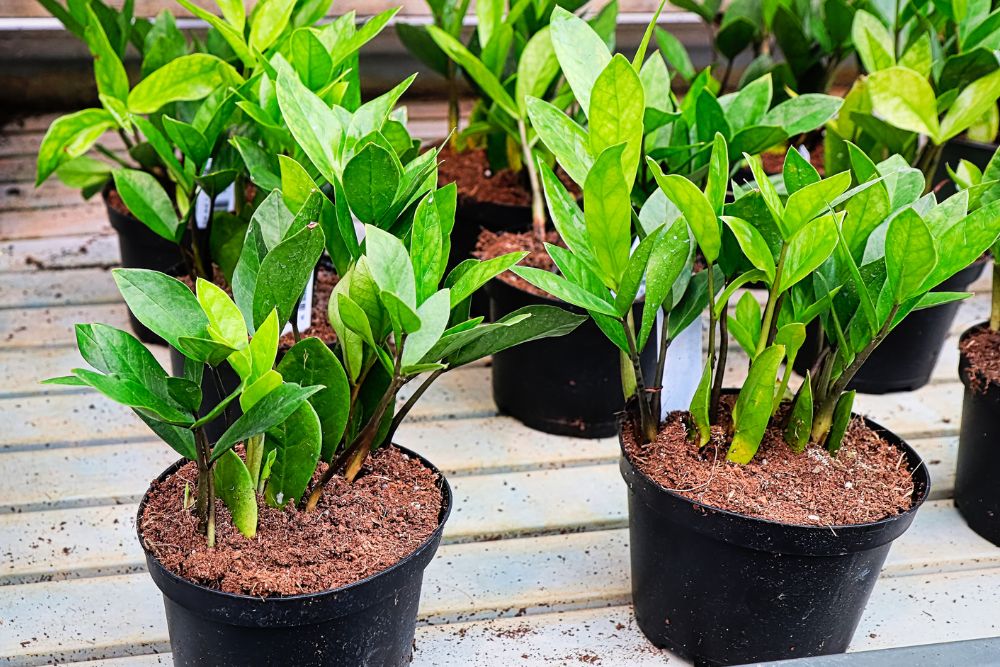
Common Pests & Diseases Appearing in Indoor ZZ Plants
The insects that appear in your ZZ plants are also common to many other indoor houseplants. They include aphids, scale insects, mealybugs, and whiteflies. Scale insects come out on top. They affix themselves to leaves and drink the sap. If you see dropping foliage with distortion, look at the underside of the foliage. You can use soapy water and a cloth to remove these.
Diseases
Downy Mildew (also Gray mold): You will see pale green splotches on the top of the leaves. Use a sulfur fungicide as treatment. There’s also root rot, it’s typically from overwatering. You may need to remove the plant from its pot, clip away mushy or dead roots, then repot it in fresh soil (in case there’s any lingering fungal infection). Afterward, be diligent about your watering practices.
In 1829, the ZZ plant became part of the genus Caladium zamiifolium. In 1856 it changed to zamioculcas, and finally the current name (zamiifolia) stuck.
As a resident of Africa and Kenya, the plant grew outdoors with little notice. The Dutch nurseries in South Africa recognized an opportunity for propagation, followed by world distribution (1996). It didn’t take long thereafter before you could find Zanzibar Gem Plants in local garden stores.
Troubleshooting Common ZZ Plant Problems
- Brown leaves: Excess light, heat, over fertilizing, or low humidity. Move the plant out of direct light, increase humidity around the plant, and check the instructions on the fertilizer you use.
- Irregular leaf spots: usually a sign of insects. Check the entire plant for any signs, then take action.
- Smelly soil: You have root rot. You will need to find a new home for your plant with fresh soil. Take the time to trim roots that look sickly first.
The Best of the Best: In January 2018, the Tropical Plant Industry Exhibition recognized the “Raven” as the Best New Plant. People were excited about the way in which Raven melds with many decorating schemes, adding a little style (think “little black dress” of the plant world).
[wp-faq-schema title=”Frequently Asked Questions About The Zanzibar Gem Plant” accordion=1]Summary
The Zanzibar Gem Plant appears repeatedly on lists of the easiest plants to grow. This is a great beginner’s plant because it’s really hard to kill them. You can group different sized plants in an arrangement for just the right touch in a living room or family room. It looks lovely draping at the end of a sideboard. As a green ornamentation, the ZZ plant can really fit into any home or work environment.

